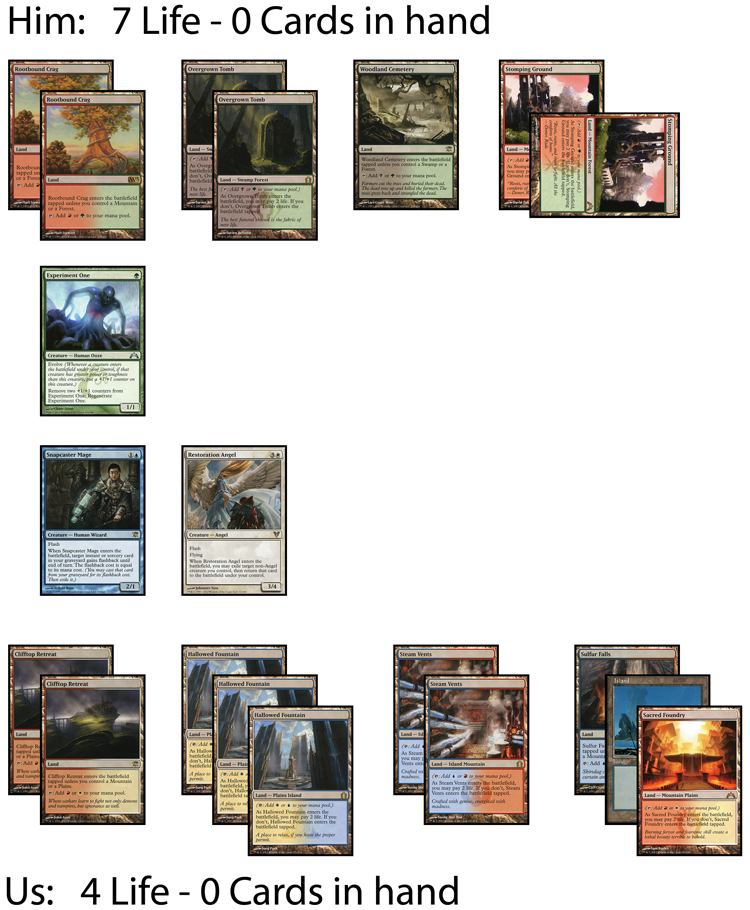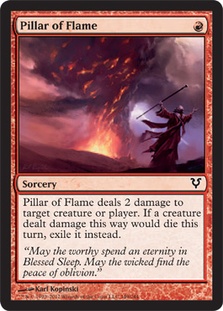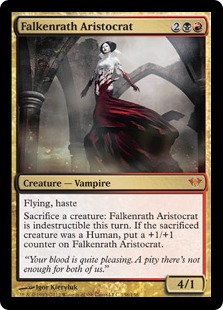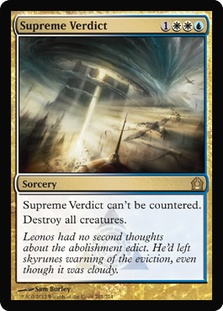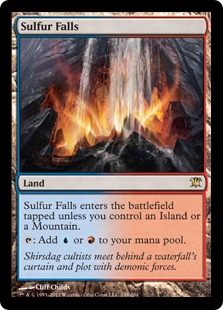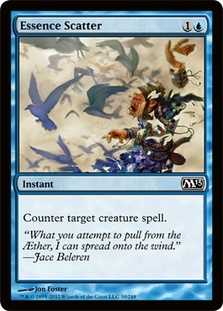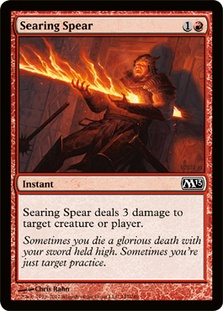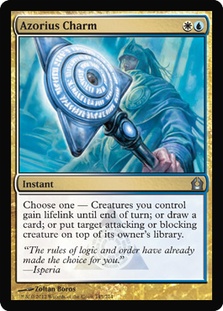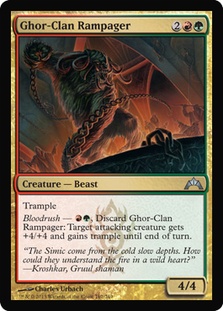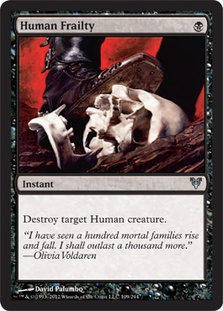Editor’s Note: It’s articles like this that make me both love my job and realize how lucky I am to have Jim as a part of our wonderful stable of writers. I hope you enjoy this article just as much as I did.
Last article we were looking at a situation I found myself in during the Standard portion of the StarCityGames.com Invitational in Atlanta, and this week we are going to be examining both what I did and perhaps what I should have done.
We are playing U/W/R Flash:
Creatures (11)
Lands (24)
Spells (25)

And our opponent is playing something similar to this Magic Online decklist:
Creatures (31)
- 4 Strangleroot Geist
- 4 Falkenrath Aristocrat
- 2 Hellrider
- 4 Flinthoof Boar
- 3 Dreg Mangler
- 3 Deathrite Shaman
- 3 Burning-Tree Emissary
- 4 Experiment One
- 4 Ghor-Clan Rampager
Lands (20)
Spells (9)

It is very late in game 1, and the board is as follows:
It is our upkeep, and we draw our card for the turn:
What do we do?
…
…
I think this is about where we left off.
As soon as I saw that I drew Pillar of Flame, I put it face down on the table and snap attacked. My opponent thought for a while, seeming somewhat surprised by the attack, and after a long deliberation decided to block my Snapcaster Mage with his Experiment One. He went to four, and I said go.
He promptly drew Falkenrath Aristocrat and killed me.
In this scenario, my thought process was that by quickly glancing at the card I had just drawn, putting it down immediately, and attacking, I was signifying that it was a blank. If it is a blank, having Experiment One in play against an open board is a huge advantage, as it increases his outs from just Hellrider and Falkenrath Aristocrat to those two cards along with Strangleroot Geist, Flinthoof Boar, Dreg Mangler, Searing Spear, and Ghor-Clan Rampager. That’s a lot of outs.
However, I think my logic was flawed, my execution questionable, and my play perhaps even completely incorrect. If I had drawn a blank, I would need to consider my attacks a little more carefully. This situation is surprisingly complicated, so let’s look at all my reasonable options:
1. Attack with both Snapcaster Mage and Restoration Angel
- If he blocks and draws Falkenrath Aristocrat or Hellrider, I’m dead.
- If he blocks and draws anything but Dreadbore, he’s dead.
- If he does not block, he’s dead.
That’s what I did. Let’s look at another.
2. Pillar of Flame the Experiment One, and then attack with both Snapcaster Mage and Restoration Angel
- If he draws Falkenrath Aristocrat or Hellrider, I’m dead.
- If he draws anything else, he’s dead.
It seems like a logical play, but it’s worse than what I did on the basis that it does not have the ability to win the game on the spot. This play only makes sense if you’re completely sure he’s going to block, as you would rather have a Snapcaster Mage in play than a Pillar of Flame in hand and want to put him dead on board the following turn unless he is able to draw a Hellrider or Falkenrath Aristocrat and kill you.
3. Pillar of Flame the Experiment One, and then attack with only Snapcaster Mage
- If he draws a blank, he’s dead.
- If he draws a Falkenrath Aristocrat, I will block with my Restoration Angel and have him on a three-turn clock with Snapcaster Mage. It will likely come down to the tops of our decks.
- If he draws any other creature or removal spell, this will clutter up the board so my Snapcaster Mage can no longer attack profitably, and if I attack with Restoration Angel, I am again opened up to Falkenrath Aristocrat or Hellrider. Again, it will come down to the tops of our decks.
This play is safer in the short term but a bit more risky in the long term. We won’t just die to a Hellrider or Falkenrath Aristocrat, but if we brick and he draws a spell, we’ll be back where we started. Of course, we also have many powerful topdecks, but we are giving our opponent more chances to outdraw us.
The big question here is what is better? Do we want to put our opponent in a situation where he might just lose and if not has one turn to draw an out? Or would we rather play it safe and give him a few draw steps to outdraw us?
Our Opponent’s Point of View
After looking at it from our side of the table, the next important factor is to look at this from our opponent’s point of view. He sees us attack quickly with both of our guys, which seems to leave him with quite a few outs in conjunction with his Experiment One. Why would we do that? What does our play say about what we might have drawn?
If we drew a Sphinx’s Revelation, the game is essentially over, and it doesn’t matter.
If we drew a Snapcaster Mage or a Restoration Angel, the game is essentially over since our graveyard is stocked, and it really doesn’t matter.
If we drew a Dissipate or Rewind, we will counter our opponent’s next play; the game is essentially over, and it doesn’t matter.
If we drew a Think Twice, Auger of Bolas, or Thought Scour, we would likely cast it before combat.
Our opponent can pretty much rule out all of these scenarios. So let’s look at the relevant cards we could have drawn:
If we drew a land or a Supreme Verdict, these are blanks, and if our opponent does not block, he has a ton of outs to just kill us.
In this case, our opponent does not want to block.
If we drew an Essence Scatter, it will cut off any creature-based out that our opponent has but still leaves Searing Spear to just kill us and Dreadbore as an out to survive.
In this case, our opponent does not want to block.
If we drew a Pillar of Flame or a Searing Spear and our opponent does not block, he will die.
In this case, our opponent wants to block.
If we drew Azorius Charm, we have a few options with it:
If we drew Azorius Charm, we have a few options with it:
1. We can attack with both guys and lifelink to gain five life.
2. We can attack with both guys, and if he blocks we can put the Experiment One on top of his deck.
3. We can attack with both guys, and if he blocks we can use Azorius Charm to defend against the counterattack.
4. We can attack with both guys, and if he does not block we can use Azorius Charm to defend against a counterattack and win the following turn.
Of these, it seems like option 1 is the best, as it both plays around our opponent’s topdecks and lets us make the most aggressive attack. Options 2 and 3 still give him a draw step to beat us since they put the board in the exact same scenario the following turn, and option 4 still loses to Hellrider and stalemates with a non-attacking Falkenrath Aristocrat or Dreadbore.
In this case, our opponent wants to block, as it will give him two more draw steps to find a Dreadbore, Falkenrath Aristocrat, or back-to-back haste creatures for the win.
So:
If we have nothing, our opponent does not want to block.
If we have Essence Scatter, our opponent does not want to block.
If we have a burn spell, our opponent wants to block.
If we have Azorius Charm, our opponent wants to block.
But, of course, our opponent does not know what we have—it’s up to him to figure that out. When we make our attack with Snapcaster Mage and Restoration Angel, our opponent has to consider why we’re making this attack. What are we trying to say about our hand?
When we make the attack, our opponent must consider that we understand we are dead to almost half the cards in his deck if he does not block and survives the turn. So our opponent could use this information to deduce that we have a burn spell and that he must block to survive.
But what if we actually did draw a blank?
If we did draw a blank, the safest play would simply be to not attack at all and hope we draw something relevant in the next turn or so. This ensures we don’t die to his many possible topdecks and presents a fairly good defense.
But what if we wanted to turn our Snapcaster Mage into a removal spell for his Experiment One and sneak through three damage? We could make this same attack knowing he would likely block. But is that advantageous for us?
If we don’t have anything, his Experiment One survives the turn, and he draws Ghor-Clan Rampager, suddenly we’re behind on board and dead to a lot of draws.
If we don’t have anything, his Experiment One survives the turn, and he draws Falkenrath Aristocrat, we’re going to lose our Restoration Angel when we block and be dead on board for the following turn.
So yes, we can see there are definitely reasons why we would want to trade our Snapcaster Mage for his Experiment One now, and we would make this attack despite having drawn nothing based on the fact that he probably should block to avoid dying to a burn spell. While we will still die to a topdecked Falkenrath Aristocrat, we would be in bad shape against one either way.
Beyond all this analysis, there is also the human element to consider. How has your opponent been playing? Does he have the ability to make all the deductions you have made, and if not what level of thinking will he stop at? What do you think his perception of you as a player is? Does he think you are good enough to recognize everything we have thought through, or do you seem like you are playing overly aggressively or defensively?
Win Equity
Finally, there is one more consideration to make, which I am going to call “Win Equity.” If we attack and he decides not to block for whatever reason he sees fit, we win, and the game is over. The top card of both of our decks is irrelevant, and we can pick up our cards and go to game 2. This is something that is difficult to quantify but hard to ignore.
It’s like playing heads up at the end of a poker tournament—that you are one of the last two players playing. Think playing in the finals of a tournament. When you have more chips than your opponent, you’re somewhat more inclined to go all-in because you know that if you win the tournament is over. If you lose, you may be putting yourself in a disadvantageous position, but you can still come back to win. Winning now ices the game and does not give your opponent this luxury.
So Jim, what’s the play?
Honestly? I don’t really have a solid answer beyond knowing that my quick choice to attack was wrong. While my heart might have been in the right place, this is a complicated board state that requires at least a few seconds of thought, and the only card I could have drawn that would make me attack so quickly is a Pillar of Flame or a Searing Spear.
It seems like casting Pillar of Flame on the Experiment One and attacking with just the Snapcaster Mage is the safest play, but the allure to simply win the game on the spot is hard to ignore.
Please let me know what you think in the comments, and thanks for reading.
http://www.facebook.com/jimdownside
(I highly encourage all comments and feedback. Feel free to either post in the comments of the article or message me directly on Facebook. Please also feel free to follow me on Facebook, but don’t be offended if I don’t accept your friend request; I only add people I’m acquainted with in person.)
 |
I am Izzet. A crust of calculating and neverending thought covering a molten core swirling under the surface. |

